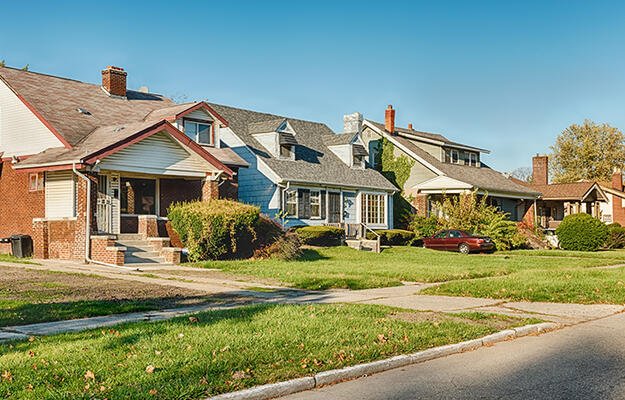Even as American Dream Changes, Housing Is Central to the Economy
For generations, a healthy housing market has been central to the growth and prosperity of the American economy. Today, as Americans rethink the "American Dream" in the aftermath of the Great Recession, a new era of housing – one defined by diverse housing options, responsible financing methods and design innovations – is once again central to the nation's economic growth.
America’s new era of housing will look drastically different from the suburban tracts and “McMansions” that have defined recent decades. Traditionally, the American Dream was widely defined by a detached suburban single family home, with two cars in every driveway and a white picket fence. Today, due in part to changing demographics, the American Dream is no longer so homogeneous.
According to the How Housing Matters survey, which was commissioned by the John D. and Catherine T. MacArthur Foundation, 57 percent of adults believe that “buying has become less appealing,” and 54 percent believe that “renting has become more appealing” than it was before. While more than 7 in 10 renters still aspire to own a home one day, 3 in 5 adults believe that “renters can be just as successful as owners at achieving the American Dream.”
These changing attitudes about the primacy of homeownership are converging with changing tastes in housing stock. Today, particularly among Generation Y and Baby Boomers, an increasing number of individuals are valuing walkability, multimodal transportation, small and more manageable units and proximity to employment centers and urban cores.
Taken together, these major forces are altering the development of housing in the United States, yet the benefits of housing remain unchanged. Regardless of whether individuals rent or buy, housing in America continues to create jobs and support economic growth.
The Economic Benefits of Housing
The economic benefits of housing begin even before a new housing development breaks ground, as pre-development work is underway. From the labor and materials directly involved in construction to the suppliers and then the further ripple effects as wages turn into local spending, housing construction – of all sizes and supporting all income groups – supports jobs throughout the economy. According to economic estimates from the National Association of Home Builders, construction of an average rental apartment creates 1.13 jobs and $42,383 in taxes, and construction of an average single-family home creates 2.97 jobs and $110,957 in taxes.
An adequate supply of housing for all income groups has additional economic benefits to local businesses. Housing costs are an important factor in an employer’s ability to attract and retain qualified employees and thereby sustain and grow their business. A national survey of more than 300 companies found that 55 percent of large companies say there is a significant lack of affordable housing nearby. Furthermore, two-thirds of these respondents say the shortage has a negative impact on recruiting qualified employees, and a majority report that it leads to employee turnover. In an annual survey of corporate site selection consultants, more than 2/3 report that availability and cost of nearby housing are critical considerations for businesses considering relocation, and the importance of housing for corporate location decisions has been rising.
Finally, ongoing economic and fiscal benefits accrue from apartment operations or home repairs and maintenance. Over the course of a year, 100 apartments in a typical metro area generate $2.3 million in local income, $395,000 in local government revenue and 32 local jobs, according to calculations by the National Association of Home Builders. Additionally, the report notes that a family moving into a new home will, on average, spend about three-fifths of its income on goods and services they purchase from local businesses. In the process, they not only pay sales taxes, but they support the growth of business in a community, which in turn pays its own taxes to local, state and federal coffers.
Economic Growth and Affordability
To support continued local economic growth, policymakers and private enterprise must ensure that housing options remain affordable in proximity to job centers.
Perhaps nothing has been more successful in providing access to secure and affordable housing than the Low-Income Housing Tax Credit. Since its inception, the Low-Income Housing Tax Credit has produced and financed more than 2.5 million affordable apartments, and generated approximately $7.1 billion in economic income and approximately 95,000 jobs per year. Further, the National Association of Home Builders estimates that in its first year a typical 100 apartment unit LIHTC development will generate $8.7 million in economic impact and $3.3 million in additional taxes for federal, state and local governments.
Housing developments that are affordable also open economic opportunities to millions of Americans. For low-income families, paying an affordable rent is associated with greater spending on child enrichment. Affordable housing can also reduce children's residential instability, which has been associated with reduced earnings in adulthood. Affordability matters for adults' work as well; receiving a housing voucher has been connected with an increase in work hours five years later. These studies build upon the growing knowledge that affordable and stable housing is a foundation for positive benefits that ripple throughout a community.
Looking Ahead
The connection between the health of a housing market and the strength of a local economy is clear. In the coming years, local, regional and national leaders have an opportunity to create jobs, expand revenues and strengthen local economies by focusing on efforts to help grow local housing markets.
A policy landscape that supports housing access across the income spectrum can help support economic growth while improving children's pathways to future success. Housing affordability is both compatible with and an element of a sustainable and prosperous local economy.

